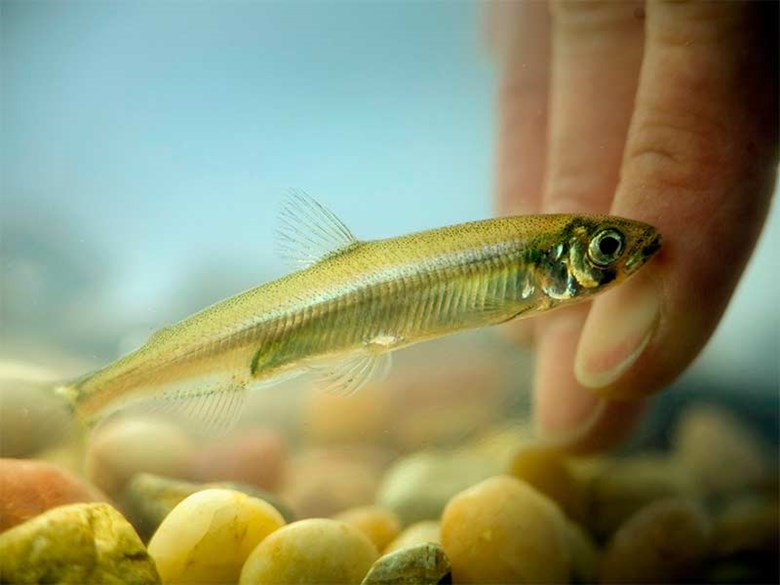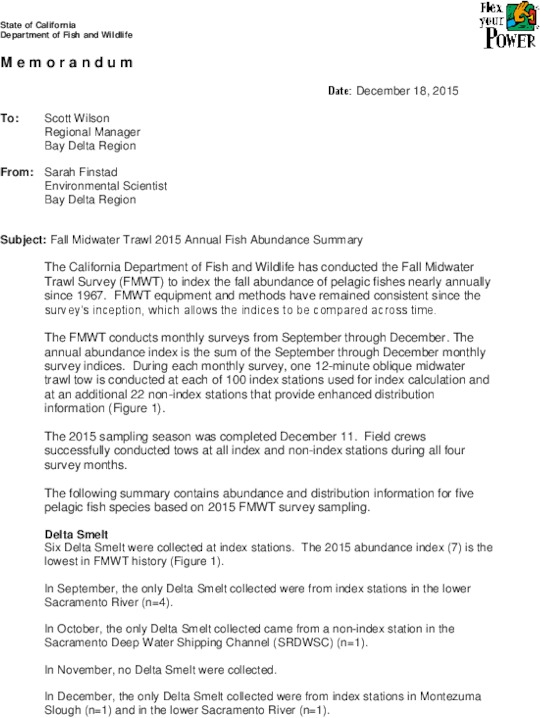From the Open-Publishing Calendar
From the Open-Publishing Newswire
Indybay Feature
Delta Smelt and other fish species plummet to record low levels
Bill Jennings, Executive Director of the California Sportfishing Protection Alliance (CSPA), said the fall survey shows the “continuing collapse of the estuary caused by the failure of the state and federal regulatory agencies to comply with the law.”
Photo of Delta Smelt courtesy of California Department of Water Resources.
Photo of Delta Smelt courtesy of California Department of Water Resources.

California's Biggest Environmental Disaster: Delta Smelt and other fish species plummet to record low levels
by Dan Bacher
Fish species ranging from endangered Delta Smelt to Striped Bass continued to plummet to record low population levels in 2015 in the Sacramento-San Joaquin River Delta, according to the annual fall survey report released on December 18 by the California Department of Fish and Wildlife (CDFW).
Only 6 Delta smelt, an endangered species that once numbered in the millions and was the most abundant fish in the Delta, were collected at the index stations in the estuary this fall. The 2015 index (7), a relative number of abundance, “is the lowest in history,” said Sara Finstad, an environmental scientist for the CDFW’s Bay Delta Region.
The Delta Smelt, a 2 to 3 inch fish found only in the San Francisco Bay-Delta Estuary, is an indicator species that demonstrates the health of the Delta, an estuary that has been dramatically impacted by water exports to corporate agribusiness interests and Southern California water agencies during the record drought, along with other factors including increasing water toxicity and invasive species.
The Fall Midwater Trawl Survey, used to index the fall abundance of pelagic (open water) fishes most years since 1967, conducts monthly surveys from September through December. The 2015 sampling season was completed on December 11.
“In September, the only Delta Smelt collected were from index stations in the lower Sacramento River,” said Finstad. “In October the only Delta smelt collected came from a non-index station in the Sacramento Deep Water Shipping Channel.”
In November, no Delta Smelt were collected - and in December, the only Delta Smelt collected were from index stations in Montezuma Slough and the lower Sacramento River, according to Finstad.
The population of striped bass, a popular gamefish, has also declined to record low levels. The 2015 abundance index (52) is the second lowest in history. Only 42 age 0 striped bass were conducted at the survey stations, noted Finstad.
Likewise, Longfin Smelt, a cousin of the Delta Smelt, declined to the lowest abundance index (4) in the history of the survey. Only 3 longfin smelt were collected at the index stations throughout the three-month period.
The abundance index (806) for Threadfin Shad, an introduced species from the East Coast that provides forage for larger fish, reached its eighth lowest level in survey history. The biologists collected 634 Threadfin Shad at the index stations.
Finally, the 2015 abundance index (79) for American Shad, a relative of the Threadfin Shad that is pursued by anglers on Central Valley rivers every spring, is the lowest in history of the survey. Only 59 American shad were collected at the index stations.
Bill Jennings, Executive Director of the California Sportfishing Protection Alliance (CSPA), said the fall survey shows the “continuing collapse of the estuary caused by the failure of the state and federal regulatory agencies to comply with the law.”
“Every survey conducted, including the 20 mm Delta Smelt, spring Kodiak trawl, summer tow net, and the fall midwater trawl surveys, shows record low levels of the fish surveyed,” said Jennings.
He emphasized that in spite of the continuing record drought conditions, that water exports south of the Delta through the state and federal pumping facilities averaged 7500 cubic feet per second (cfs) over the past week. “The State Water Project pumps are averaging 5154 cfs, while the Central Valley Project Pumps are averaging 2360 cfs,” said Jennings.
As fish populations continue to collapse, the California Department of Water Resources and Bureau of Reclamation are going forward with permit petitions to the State Water Resources Control Board to change the point of diversion on the Sacramento River to implement Governor Jerry Brown’s Delta Tunnels Plan, the so-called “California Water Fix.”
Jennings and other public trust advocates point to these latest fish survey results — and the state and federal water agencies’ permit petitions to divert more water from the Sacramento River at new diversion points — as just more evidence of the “capture of the regulators by the regulated.”
The current collapse of Delta fish species occurs as part of a long-term decline. The operation of the state and federal water projects by the California Department of Water Resources and Bureau of Reclamation Reclamation has brought fisheries to historic lows.
Since 1967, populations of striped bass, Delta smelt, longfin smelt, American shad, splittail and threadfin shad have declined by 99.7, 98.3, 99.9, 97.7, 98.5 and 93.7 percent, respectively, according to Jennings.
The natural production of Sacramento winter-run and spring-run Chinook salmon has declined by 98.2 and 99.3%, respectively, and are only at 5.5 and 1.2 percent of doubling levels mandated by the Central Valley Project Improvement Act, California Water Code and California Fish & Game Code.
To make matters even worse, over 95 percent of endangered juvenile winter-run Chinook salmon perished in lethally warm water conditions on the upper section of the Sacramento River in 2014 and 2015, due to mismanagement by the state and federal water agencies.
"Our captive regulatory agencies are sending fisheries to the scaffold because the demands of special interests outweigh the protection of public trust resources belonging to all Californians," concluded Jennings.
by Dan Bacher
Fish species ranging from endangered Delta Smelt to Striped Bass continued to plummet to record low population levels in 2015 in the Sacramento-San Joaquin River Delta, according to the annual fall survey report released on December 18 by the California Department of Fish and Wildlife (CDFW).
Only 6 Delta smelt, an endangered species that once numbered in the millions and was the most abundant fish in the Delta, were collected at the index stations in the estuary this fall. The 2015 index (7), a relative number of abundance, “is the lowest in history,” said Sara Finstad, an environmental scientist for the CDFW’s Bay Delta Region.
The Delta Smelt, a 2 to 3 inch fish found only in the San Francisco Bay-Delta Estuary, is an indicator species that demonstrates the health of the Delta, an estuary that has been dramatically impacted by water exports to corporate agribusiness interests and Southern California water agencies during the record drought, along with other factors including increasing water toxicity and invasive species.
The Fall Midwater Trawl Survey, used to index the fall abundance of pelagic (open water) fishes most years since 1967, conducts monthly surveys from September through December. The 2015 sampling season was completed on December 11.
“In September, the only Delta Smelt collected were from index stations in the lower Sacramento River,” said Finstad. “In October the only Delta smelt collected came from a non-index station in the Sacramento Deep Water Shipping Channel.”
In November, no Delta Smelt were collected - and in December, the only Delta Smelt collected were from index stations in Montezuma Slough and the lower Sacramento River, according to Finstad.
The population of striped bass, a popular gamefish, has also declined to record low levels. The 2015 abundance index (52) is the second lowest in history. Only 42 age 0 striped bass were conducted at the survey stations, noted Finstad.
Likewise, Longfin Smelt, a cousin of the Delta Smelt, declined to the lowest abundance index (4) in the history of the survey. Only 3 longfin smelt were collected at the index stations throughout the three-month period.
The abundance index (806) for Threadfin Shad, an introduced species from the East Coast that provides forage for larger fish, reached its eighth lowest level in survey history. The biologists collected 634 Threadfin Shad at the index stations.
Finally, the 2015 abundance index (79) for American Shad, a relative of the Threadfin Shad that is pursued by anglers on Central Valley rivers every spring, is the lowest in history of the survey. Only 59 American shad were collected at the index stations.
Bill Jennings, Executive Director of the California Sportfishing Protection Alliance (CSPA), said the fall survey shows the “continuing collapse of the estuary caused by the failure of the state and federal regulatory agencies to comply with the law.”
“Every survey conducted, including the 20 mm Delta Smelt, spring Kodiak trawl, summer tow net, and the fall midwater trawl surveys, shows record low levels of the fish surveyed,” said Jennings.
He emphasized that in spite of the continuing record drought conditions, that water exports south of the Delta through the state and federal pumping facilities averaged 7500 cubic feet per second (cfs) over the past week. “The State Water Project pumps are averaging 5154 cfs, while the Central Valley Project Pumps are averaging 2360 cfs,” said Jennings.
As fish populations continue to collapse, the California Department of Water Resources and Bureau of Reclamation are going forward with permit petitions to the State Water Resources Control Board to change the point of diversion on the Sacramento River to implement Governor Jerry Brown’s Delta Tunnels Plan, the so-called “California Water Fix.”
Jennings and other public trust advocates point to these latest fish survey results — and the state and federal water agencies’ permit petitions to divert more water from the Sacramento River at new diversion points — as just more evidence of the “capture of the regulators by the regulated.”
The current collapse of Delta fish species occurs as part of a long-term decline. The operation of the state and federal water projects by the California Department of Water Resources and Bureau of Reclamation Reclamation has brought fisheries to historic lows.
Since 1967, populations of striped bass, Delta smelt, longfin smelt, American shad, splittail and threadfin shad have declined by 99.7, 98.3, 99.9, 97.7, 98.5 and 93.7 percent, respectively, according to Jennings.
The natural production of Sacramento winter-run and spring-run Chinook salmon has declined by 98.2 and 99.3%, respectively, and are only at 5.5 and 1.2 percent of doubling levels mandated by the Central Valley Project Improvement Act, California Water Code and California Fish & Game Code.
To make matters even worse, over 95 percent of endangered juvenile winter-run Chinook salmon perished in lethally warm water conditions on the upper section of the Sacramento River in 2014 and 2015, due to mismanagement by the state and federal water agencies.
"Our captive regulatory agencies are sending fisheries to the scaffold because the demands of special interests outweigh the protection of public trust resources belonging to all Californians," concluded Jennings.
Add Your Comments
Latest Comments
Listed below are the latest comments about this post.
These comments are submitted anonymously by website visitors.
TITLE
AUTHOR
DATE
Southern California Water
Tue, Jan 5, 2016 1:11PM
We are 100% volunteer and depend on your participation to sustain our efforts!
Get Involved
If you'd like to help with maintaining or developing the website, contact us.
Publish
Publish your stories and upcoming events on Indybay.
Topics
More
Search Indybay's Archives
Advanced Search
►
▼
IMC Network



